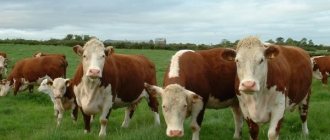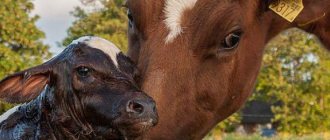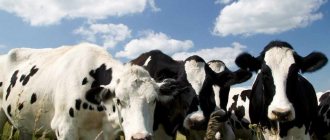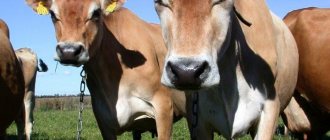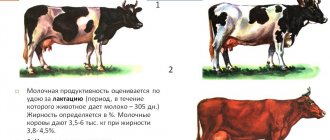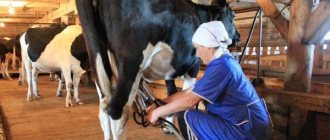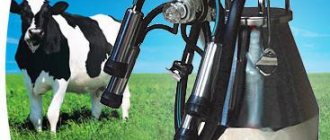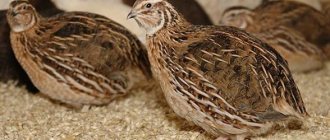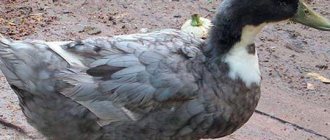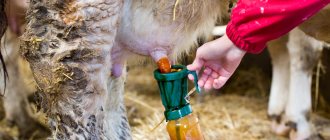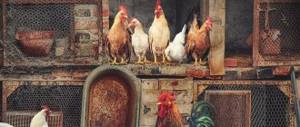The Jersey breed of cows dates back to 1789 on the island of Jersey, when local farmers improved the Norman and British species. Burenki were selected based on milk fat content. Since the import of dairy cattle was prohibited by local authorities, the breed was kept in purebred condition.
The cattle became famous in 1866, when a stud book about the breed was published. The high productivity of cows has been appreciated throughout England. In 1872, Jersey cattle became widespread in the USA, New Zealand, Africa, and Australia. Currently, the breed of cows is actively raised by Danish, Canadian, French and American farmers.
A few of these animals appeared in the USSR in 1947. Breeding individuals were delivered from the Kingdom of Denmark to the Leningrad, Moscow, Ryazan and Novgorod regions. These were bulls that were crossed with black-and-white cows to produce highly productive females.
The crossbreeds weighed slightly less than usual and produced a little milk. But it was distinguished by increased fat content, in comparison with that given by purebred black-and-white cows. Currently, Jersey cows in Russia are bred by Moscow and Ryazan farmers.
Characteristics of cattle
The breed type has a dairy direction, so individuals are characterized by an elegant small physique. The proportions of the body are somewhat angular, but generally proportional. Height is approximately 120 cm, and weight reaches 400-500 kg. Bulls are usually larger, so by adulthood they can pull 800 kg.
The advantages of the suit are high levels of milk productivity: milk is of good quality, has a pleasant aroma and delicate taste. The fresh product quickly collects a good layer of heavy cream.
The milk's high fat content and large amount of protein benefit farmers, so cost-effectiveness is another plus. A Jersey cow requires little feed. The costs, in comparison with maintaining the same Holsteins, are lower.
The shortcomings are hidden in poor meat performance. Very few meat products are produced from Jerseys. Therefore, they are completely unprofitable for a meat farm.
Jersey heifers are usually small in size and require special supervision and care after calving. On farms where calves are not given proper attention, there is a massive mortality rate.
A significant disadvantage for farms is their high price.
The average lifespan of a dairy cow is 20-25 years.
Duration depends on:
- climatic conditions;
- ecology;
- sex of the animal (females live longer than bulls);
- diet;
- quality of care;
- individual characteristics of the animal.
Interesting
On farms, the age of the herd is reduced by half, since the farmer is only interested in the period of life of the cows during which they can produce milk. Usually this is 10-12 years.
Content Features
Jersey cattle are unpretentious in maintenance and care. In summer, take care of regular walks in the pastures. In winter - a warm, ventilated room, as well as a sufficient amount of food. It is noted that the Jersey species does not like noisy environments.
The Jersey breed of cows adapts to any climate. Due to its size, the cow consumes 25-30% less feed compared to other dairy species.
Ruminant animals need to receive nutrients daily.
The main component of nutrition is protein. Its lack in the diet of a dairy Jersey cow leads to a decrease in milk yield, deterioration of fertility, and poor immunity. As a result, susceptibility to diseases increases, metabolism is disrupted, and so on.
A cow may not receive enough protein in the following cases:
- In early spring.
- In midsummer during a drought.
- Low protein feed. Examples include corn, grain silage, fodder beet and concentrates such as citrus pulp.
It is also important for animals to receive vitamins and minerals, such as calcium and phosphorus. Although the cow's skeleton contains reserves of both elements, their imbalance leads to infertility.
The daily micronutrient requirements of dairy breeds are as follows:
| Element | Requirement, mg |
| Copper | 150-400 |
| Selenium | 3-5 |
| Iodine | 12-50 |
| Cobalt | 5-10 |
| Magnesium | 335-415 |
| Zinc | 335-750 |
Animals that eat green pastures receive all the necessary nutrients and vitamins. Vitamins are added to balanced diets during the winter months.
Give animals fresh water 2 times a day.
Appearance of a Jersey cow
Characteristic features of jerseys:
- small muzzle with a narrow forehead;
- neck proportional to the body, with numerous skin sweet spots;
- the body is flat with visible rib bones;
- back concave;
- the hind hooves seem to be of irregular structure;
- the chest is wide;
- The udder of cows is large, usually in the shape of a bowl.
The color is predominantly reddish in color; there are light brown individuals. Sometimes there are dark or white spots on the legs and lower body. Bulls have a dark muzzle and neck, with an almost black stripe along the entire back.
The size of muscle mass depends on various factors. The value is influenced to a greater extent by conditions of detention and nutrition. For example, the development of muscle mass is promoted by starchy feeds, which are given only to bulls.
Since Jersey cows are dairy breeds, it is advisable to exclude these types of feed from the diet. It is advisable to keep females in clean barns: well-groomed animals are always larger than their uncleaned counterparts.
On average, for dairy cows, the size of muscle mass is 10-20% of the total weight of the animal. Its growth in females ends simultaneously with the beginning of the lactation period. Bulls continue to gain muscle mass throughout their lives.
Breed standard
| Suit | Fawn or brown |
| Live weight | Up to 400 kg heifers, up to 800 kg steers |
| Features | Dark nose, widely spaced eye sockets |
| Main type of productivity | Lactic |
| Milk yield | Up to 4000 kg with fat content of about 5% |
| Records | The best figure is 111 tons for all periods of lactation |
How to recognize a Jersey cow?
This breed is distinguished by its compact size and somewhat angular shape.
The height at the withers of an adult is approximately 1 m 20 cm. The body of the animal is flat, the ribs are oblique. The hip bones are clearly visible. The head is small with a concave forehead. The eyes are large and droopy. Cows have large, cup-shaped udders of a beautiful, regular shape. The color of the cows is red or light brown. There is a color with white tan marks. On the face the fur color is darker, especially around the eyes. The fur is soft, even a little plush, like that of a British cat.
Quality and quantity of Jersey milk
The average milk yield for 305 days in liters is 3000-3500. This is not much in comparison with the performance of other dairy breeds. For example, pieds produce up to 5000 liters of milk in 305 days of lactation. However, the same black-and-white cows show a fat content of only about 3-3.5%. Milk from Jersey cows reaches 9%.
Preparation for milking heifers should begin at an early age.
Proper milking of a heifer who has given birth to her first calf will in the future lead to significant levels of milk yield for the individual.
Jerseys have a well-developed maternal instinct, so she must feed the newborn herself for the first time.
You can show the calf to the cow two hours after calving. And in the future it is important to properly develop the udder. If you run it, it will remain hard and heavy.
Massages and rubbing will improve milk flow. In the first days after calving, you need to milk at regular intervals up to five times a day. The milking regimen can be adjusted after two weeks, and by the time the calf is one month old, they switch to three approaches a day.
How popular are Jersey cows in Russia?
This breed of cow was introduced into Russia in small quantities in the 19th century, but soon there were no traces of it left. In Russia, milk from these cows is often used to create fermented milk products, for example:
- fermented baked milk;
- kefir;
- Ricotta;
- yogurt.
Additionally, the high fat content of dairy products makes cheese, butter, cream and sour cream more palatable. Today the breed is known only in the Moscow region and in other regions of Russia, however, it is quite rare and is found only on private farms.
Feeding and housing conditions in Russia are suitable for both domestic and large-scale breeding. Since it has already been established that milk yield is low, this breed is not suitable for those who want to sell as much milk as possible as cheaply as possible. These cows should be bred for farmers who sell good and expensive milk to their regular customers or produce dairy or fermented products.
Character and habits
One of the advantages of cows of this breed is their calm behavior. They are not aggressive towards people or other animals. They have a quiet, calm and obedient disposition. Some animals may also be afraid.
When buying a calf, be prepared for the fact that it will be difficult to get used to the new owners. If a cow is moved to a new farm, milk production will decrease for some time. But after 2-3 months, cows will be able to adapt to new conditions and get used to their owners. Here you can see what the Redbat breed looks like and how productive it is in both milk and meat characteristics.
How and what to feed
Types of feed, depending on seasonality and calving, should be specialized. Feeding the animal should be moderate. Fresh grass, feed, hay and vegetables make up the main diet of individuals. Animals have modest appetites. But cows will actively eat healthy and tasty vegetable supplements, but they must be given to dairy cows with caution.
As mentioned above, the starch found in vegetables negatively affects productivity. Farmers also note the need to limit drinking. Calves should be given no more than 3-4 liters of water per drinking session, while cows need about 20 liters.
Daily ration:
| Grass | 20 kg |
| Hay | 4 kg |
| Compound feed | 5 kg |
| Beet | 5 kg |
There is no grass in winter, so the daily diet can be varied with haylage. It includes corn and sunflower. A good addition would be vitamins and minerals in the form of specialized feed.
Description of the Jersey breed
The Jersey breed of cows is comparatively smaller than other dairy species. The head is relatively long, the muzzle is wide. The eyes are placed far from each other, the forehead is narrow. The body of the species is muscular, the udder is large.
Both bulls and cows have thin and curved horns on their heads.
The characteristics of the Jersey cow breed say that modern animals come in different colors. As a rule, these are shades of fawn, but sometimes there are also gray, reddish, white or even black. Regardless of color, a cow's belly is lighter in color. Both bulls and heifers are darker in the hips, head and shoulders.
Jerseys have 32 teeth. The difference from humans is that the animal has 8 incisors in the lower jaw in front and 6 strong molars on the upper and lower jaws.
The Jersey cow breed is docile in temperament.
The average body weight of mature cows varies from 400 to 500 kg. Adult bulls weigh on average from 540 to 820 kg.
The table shows the average weight of heifers, depending on age:
| Age, months | Weight, kg | Height, cm |
| 1 | 48 | 78 |
| 2 | 66 | 83 |
| 3 | 83 | 89 |
| 4 | 100 | 93 |
| 5 | 117 | 97 |
| 6 | 135 | 101 |
| 7 | 152 | 104 |
| 8 | 169 | 107 |
| 9 | 187 | 110 |
| 10 | 204 | 113 |
| 11 | 221 | 115 |
| 12 | 239 | 117 |
| 13 | 256 | 118 |
| 14 | 273 | 120 |
| 15 | 290 | 121 |
| 16 | 308 | 122 |
| 17 | 325 | 123 |
| 18 | 342 | 124 |
| 19 | 360 | 125 |
| 20 | 377 | 126 |
| 21 | 394 | 127 |
| 22 | 411 | 128 |
Calving characteristics of the Jersey breed
The end of the Jersey cow's maturation period occurs when it is two years old. The birth usually goes well, but with minimal human supervision. Jersey cows have an innate maternal instinct, so they must immediately lick the calf. Over the entire duration of the reproductive period, the animal gives birth to 10-13 newborns, one per year.
Calving complications can appear in the form of udder mastitis due to improper milking. A calving female is highly sensitive to sounds and strangers: she may become frightened and refuse to give milk. Therefore, protect the animal from sound influences; it is better to keep animals in a soundproof barn.
Post-calving care includes milking five times a day and feeding dry food without vegetables three times a day.
The recommended regimen for watering a cow is 2 times with water at room temperature.
History of the breed
There are no written sources about where cattle came from on the island of Jersey. Presumably the Normans brought cows there during their heyday. Most likely, Norman cattle were originally crossed with British cattle. Jersey cows were first mentioned as a breed in 1700. At the end of the 18th century, the island's authorities banned the crossing of Jerseys with other cattle breeds. Up until 2008, Jersey cattle were bred pure.
Like any island population of large mammals, Jersey cattle began to shrink after arriving on the island. Today, Jerseys are considered one of the smallest cattle breeds.
Calves
The size and number of Jersey calves depends on the quality of care and maintenance of their mothers. The usual weight of a newborn is 20-22 kg, in total there are from 10 pieces during the entire reproductive period of the cow. Mortality among young animals is low, especially if they receive quality care.
The maturation period for young male animals is six months of age. By this time, the bulls reach 200-300 kg, and they can be slaughtered for meat.
By the age of one year, heifers have already reached sexual maturity, but early mating is not recommended by veterinarians. Jersey heifers quickly contract gynecological diseases. In the future she will produce some milk.
Feeding Jersey cows
These cows graze well, but do not devastate the pasture at all, being content with a moderate amount of grass.
Because of this small size, the nets require less purchased feed (feed, etc.), which saves quite a lot of money on their maintenance.
In addition to fresh grass and feed, cows should be fed hay and washed vegetables. As many shepherds note, water intake for these animals must be rationed.
While adult cows and bulls are still able to curb their appetite for water, calves are somehow irresistibly interested in drinking water. If they do not limit themselves to 3-4 liters of water per day, they will inevitably have digestive problems.
In winter, it is best to feed livestock high-quality hay. Suitable additives include concentrates, feed, straw and roots.
Dried corn and corn stalks are good for the breed. Pies, vegetables, and silage can be used as a food supplement, although such a diet is not typical for this breed due to its origin.
In the first 20 days after calving, the cow should not be given green and juicy food, otherwise the amount of milk will decrease sharply. During this period, the cow is fed only dry feed, and drinking water is given separately.
What to look for when purchasing
The condition of horns, teeth, skin, hooves, udders, and joints are important indicators of health. If a cow is purchased as a dairy cow, you need to carefully examine its udder. A highly productive individual will be one in which it significantly decreases in size after milking. There are often heifers with large udders, but practically no milk. After milking it remains voluminous and fleshy.
The live weight of the milk cow should be approximately 300 kg. A small individual will not produce large milk yields. You can tell about productivity by the teeth: the change occurs by the age of one year. After two years, the best productive period begins. It makes no sense to buy a 5-7 year old animal. Important folk signs of good dairy cows:
- massive sternum;
- wide intercostal spaces;
- a long tail.
A sure sign of high fat content in milk is the presence of wax in the ears.
Pay attention to the development of the calf, which is divided into several periods:
- newborn;
- lactic;
- functional;
- sexually mature.
The first period is ten days. During this time, the Jersey calf gets used to its new environment. Further duration is about 2 months. During this time, the internal digestive organs are improved. Functional activity improves after six months. During this time, the respiratory organs and nervous system develop. The functions of the genital organs begin to function at approximately one year in bulls and 1.5 years in heifers. Here a lot depends on heredity.
The pedigree of the Jersey bull includes several generations of purebred animals. The main catalog includes:
- Viva;
- Hermes;
- Millennium;
- Ensen;
- Avatar;
- Duster;
- Nils;
- Horoscope;
- Hephaestus.
Evaluation is carried out by progeny professionals
The bull "Hermes" of Russian origin, weighing 770 kg, appeared in 2000. The line of the breed is called "Glenmores". The Russian “Hephaestus” belongs to the same line.
"Nils" is famous among German breeding farms. Another representative of the breed - the Jersey bull "Millennium" - became the parent of 18 heads with a milk yield of 5475 kg per year, milk fat content of 5.7% and protein content of 3.42%.
Its catalog number is 1317, and the entire line is called “Secret Signal Observer”. The live weight of the animal is 720 kg. He was born in Denmark in 2001.
Features of milk yield
On average, the annual milk yield per animal is small - no more than 4 thousand liters of milk. This figure is different from simple dairy cows. An important advantage of cows of this breed is the high fat content of the milk - about 8%, these characteristics are similar to the famous buffalo milk, which is used to make mozzarella cheese.
The fat content of the milk is so high that the cream floats to the top in the shortest possible time and a dense layer is formed on the surface of the container. The taste of the milk is excellent. But since such animals have a small body weight, very little meat is obtained from one individual, this is considered a disadvantage of the breed. One individual will produce about 180 kilograms of pure meat.
Disease characteristics of the Jersey cow
The individual inherited from its ancestors high immunity from diseases. Despite their low weight, the animals are distinguished by strong limbs. They are not afraid of leg diseases that affect other breeds.
Together with water, individuals get a disease such as hemonchosis. It enters the body along with the nematode larva, which lives in water bodies, and its active period occurs in the spring. Ingestion of larvae can occur along with grass from puddles and small ditches.
Then they develop in the body and after about 20 days, the animal that has swallowed the nematode experiences loss of appetite and weakness.
To prevent the disease, it is important to carry out deworming on time. Veterinarians know about timely deadlines, and specialists will also administer the necessary anthelmintics.
Important
When it is hot and dry, animals can be infected by botfly larvae, this begins in the summer. The beetles disturb the animals, causing milk production to decline. To avoid this, it is important to treat the skin of animals with chlorophos in a timely manner. This is a colorless liquid and will not harm cattle.
For prevention, it is recommended to administer anthelmintic drugs before walking on pastures.
Advantages and disadvantages
Like any other breed of cattle, the Jersey breed line offers a number of individual advantages that have made it popular throughout the world. These include:
- high fat content, as well as protein and calcium in milk, which increase its overall value and usefulness;
- relatively increased milk productivity;
- high resistance to udder diseases and general diseases of cattle;
- rapid adaptation to new climatic conditions;
- hard, durable hooves that protect the limbs from injury and deformation;
- childbirth takes place as easily as possible and in most cases without complications, which is facilitated by the appropriate constitution;
- low weight requires a minimum amount of feed to maintain normal functioning of the body;
- unpretentiousness to living and feeding conditions.
Reference. Such cattle treat the pasture with extreme care, without trampling down the vegetation on it. The animal lies down only in those areas of the meadow where all the grass has already been eaten.
But when describing the breed, several of its disadvantages should be highlighted. These include:
- minimal meat productivity;
- the animal’s rather high timidity, due to which the cow cannot get used to the owner, the milkmaid and new living conditions for a long time;
- a certain curvature of the hind limbs.
Cows have a certain curvature in their hind legs.
Where can I buy cows?
In the Russian expanses there are no professional farms where one could purchase a heifer or bull with pedigree documents. Due to its rarity, the cost of a Jersey cow is quite high.
You can find heifers and bull calves only on private farms in the central regions of the country.
There is no need to talk about breed passports for such purchases. Private individuals cannot provide documents.
There are proposals to deliver individuals in batches from abroad. But no one offers pedigree papers in this case either. Added to this is the risk of purchasing animals with various diseases.
Jersey cow with photo is sold according to advertisements posted by private owners from Moscow and the Moscow region: Mendeleevo, Shchelkovo, Pushkino, Krasnogorsk.
There is isolated information about sales from Tolyatti, Anapa, and Yekaterinburg. The cows in the photographs look like purebred representatives.
Reviews from owners of Jersey cows
Victor Antonov, p. Beshenkovichi
I bought a couple of Jersey cows for my cows, I didn’t think about what I would cover with them. It turned out to be very difficult to find a Jersey bull. But they need to calve in order to produce milk. Well, they recommended a medium-sized Ayrshire bull. Covered. Calved normally. Now I am raising one Jersey-Ayrshire cross. I wonder what will happen. The Jerseys themselves are really milk-producing, but the fat content of the milk is lower than the advertised 6%.
Alexey Lukyanov, p. Novoselitskoye
We started the business with traditional black and white cattle. Slowly they looked for the most dairy breed. Unfortunately, you don’t really have to believe the advertising. In addition to Holstein, we tried Ayrshire. And recently they took a dozen Jerseys and a bull from the breeding farm. We will also try the bull on Ayrshires and Holsteins. Perhaps the crossbreeds will be quite successful in both milk and meat terms. We were immediately warned that it is not profitable to raise Jersey bulls even for meat. The lethal yield is too low. So we will either sell the bulls straight away, or we will cover the queens with an Ayrshire bull. When it comes to milk, Jerseys are really profitable. For now we will keep the purebred heifers for ourselves.
Average price of Jersey cows
There is not much variety in value because there are few sales announcements. Private traders offer heifers from 70,000 per head. Three-year-old cows sell for $1,300. Six-month-old male calves can be found for 50,000 rubles. Small week-old animals are offered from 180 rubles per kg of live weight or 30,000 per animal without weighing.
Jerseys can be brought from Europe. Delivery is possible to Moscow and the region from Denmark. The minimum quantity is one livestock truck, which is approximately 30-33 pieces. The price for an adult is 150,000 rubles.
